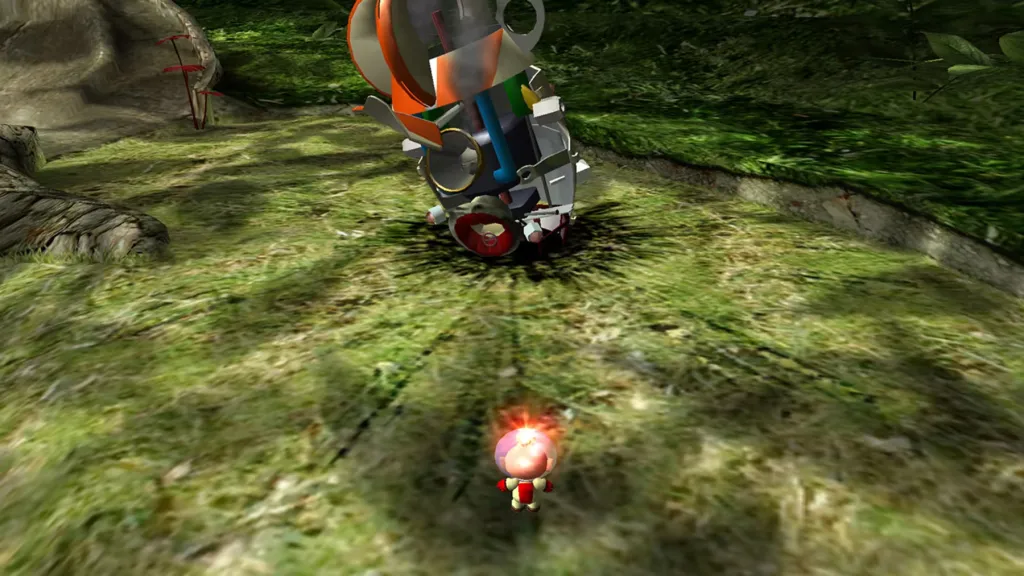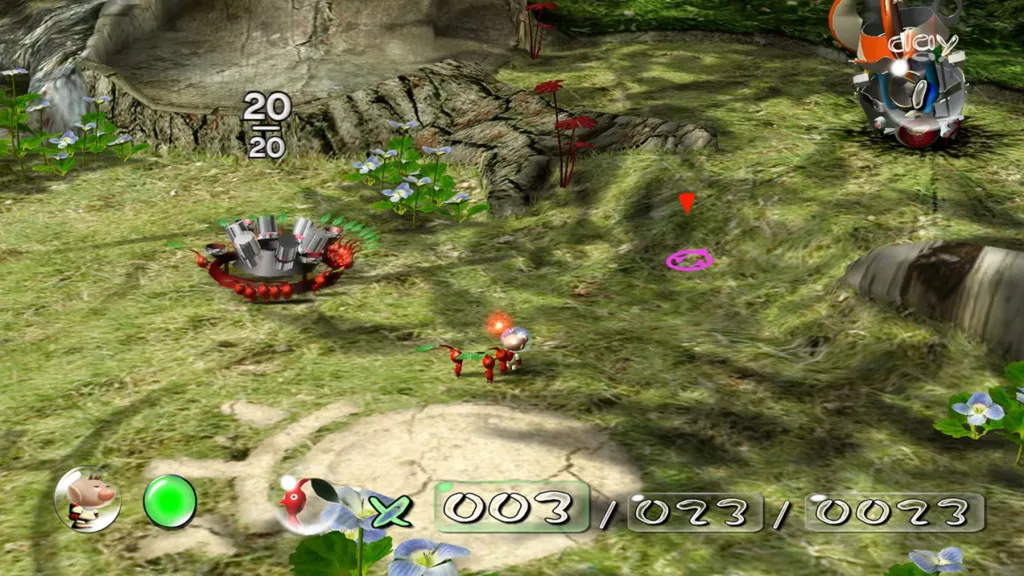Like most people in 2001, my first exposure to Pikmin wasn’t through magazine advertising in Nintendo Power or a demo kiosk at my local Toys “R” Us, but through Luigi’s Mansion. Tucked away in the options menu was a trailer for the game that showed off what to expect from this new Nintendo IP. It stated that you were stranded on a mysterious planet and needed to use the local wildlife, the Pikmin, to find a way home. The trailer showed off some early in-game footage alongside levels that would appear in the game, but the trailer gave off a distinct impression that Pikmin wouldn’t be like your average Nintendo game.
Most Nintendo games were very personable with distinguishable leads and worlds. You could identify a Nintendo-developed game in the ‘90s just from how bright and colorful they were. Advertising showed off the whimsy and wonder of Mario, Pokémon, and The Legend of Zelda, but Pikmin didn’t really have that. Pikmin had a relatively mundane world at first glance. Even the trailer shown in Luigi’s Mansion had a lot of flat plains without much life to them. Yet it’s that lack of traditional Nintendo elements that made the original Pikmin stand out from every other Nintendo franchise and even its later installments.
There’s almost always a sense of immediacy in the game design of Nintendo games. You’re usually thrown into the action pretty quickly, whether it’s World 1-1 in Super Mario Bros. or fiddling about with Mario’s face in Super Mario 64. Nintendo prefers to let you experiment with its mechanics rather than guide you through a dedicated tutorial. Pikmin lets you wander around its opening area, but there’s a fairly sizable tutorial for the game. There’s still plenty of experimentation once you learn the mechanics, but there’s no immediate sense of freedom.

That was probably one of the reasons why I never gelled with Pikmin growing up. I played it, but I found myself bored of the more laid-back and somewhat aimless pace yet also overwhelmed by the pressure the game had with its numerous ticking clocks — one for how long you could spend in a level and one for how many days you could stay on the planet. Keep in mind, I was no more than 10 and used to fast-paced platformers like Sonic Adventure 2: Battle and Sly Cooper and the Thievius Raccoonus. I never played a game quite like Pikmin, and it went against everything I knew about the company. In order to succeed in Pikmin, it didn’t require good reflexes. It required planning and execution.
You needed to plan your day properly in order to get parts for your ship before night fell. The ticking clocks that permeated the game added a different type of urgency that Nintendo wasn’t really known for. In terms of genre, Pikmin was unexplored territory for a lot of gamers, especially those that just bought a GameCube.
Speaking of which, the actual territory you explored was, again, very untraditional for a Nintendo game. Instead of exploring a fantastical world, you were venturing across Earth. You were microscopic, but it was still Earth, with all of the flora and litter you would expect. There was a familiarity to this world, unlike in most of Nintendo’s earlier efforts that were firmly rooted in fantasy. Future games would be more blatant with this by showing random brand items like a Duracell battery, a rubber duck, or Nintendo hardware, but the first Pikmin did this by just presenting the nature of our planet as is.

This made most of Pikmin feel understated. The world was just presented as is, and players were meant to draw whatever inferences they could about it. It wasn’t exactly a world that we could learn that much about since the focus was more on the gameplay loop and the predicament that Captain Olimar found himself in. Everything was pretty muted, including the reaction Captain Olimar had to the discovery of the Pikmin, coming across a new creature, or discovering a piece of your spaceship off in the distance. The spectacle was all but removed here.
In a way, the one Nintendo series that Pikmin closely resembles is Metroid. In basically every Metroid game, you are placed in a new, unknown, and undeniably hostile environment and are meant to search and explore the world at your own pace. Metroid is oppressive. Metroid is isolating. There is always the distinct impression that you are the outsider here, and the environment is actively trying to stop you, with the Space Pirates retaliating against you, Metroids protecting their home planet, or the X parasite seeking symbiosis. When the bosses present themselves in Metroid, it is clear you have to fight for survival.
Pikmin instead portrays you as a visitor to a world that does not see you as a threat. There is the threat that if you stay on this planet for over 30 days you will die, but that’s not because the Bulborbs or the fauna are trying to kill you. It’s just because the environment is not hospitable to you. You’re exploring these small and self-contained areas that are bursting with life and beauty that aren’t actively hunting you, but they’re nonetheless dangerous. Bosses reveal themselves unceremoniously because this is where they live. Of course they would emerge when they feel an outside presence, whether they are a threat or not, and can decimate you and your Pikmin if you aren’t prepared. At any moment, this casual and serene world can instantly become deadly and devastate you.

Future games would forget this crucial element. They would overpopulate the world and make sure that some of these creatures are threats, distinctly presenting some of these enemies as bosses and creating areas that feel unnatural and fabricated, like the caves of Pikmin 2. They try to make the world more cartoony and in line with the perception of what Pikmin is — a game where you lead a bunch of bright and colorful plants around and discover items. The games no longer felt understated, and they became more in line with how most Nintendo games present themselves to the player.
Take the stories in the original Pikmin and Pikmin 3. In Pikmin, we have a silent intro cutscene with the only story beats told in-between days where Olimar documents his excursion for the day or talks about his life at home. Contrast that with Pikmin 3, where we have numerous cutscenes with multiple characters talking to each other in their spaceship or in the environment. In Pikmin 3, the plot is more present, while the original game only uses its dialogue as flavor text to let you learn a little bit more about how Olimar views his predicament. But even then, to have a game with a plethora of character beats and moments dedicated to Olimar is against how Nintendo usually leaves its protagonists as blank slates.
But there’s a ton of charm in how understated Pikmin is. I wouldn’t say that of any of Nintendo’s other franchises. They usually have clear and defining tones and aesthetics and present themselves as friendly and approachable, while the original Pikmin just opts to be itself. It’s a microscopic view of our world. Everything about this game is miniscule compared to how Nintendo developed its games at the time, and it slowly moved away from that with future Pikmin installments. As an adult, I find the Pikmin series quaint and comforting, but that first Pikmin just has something special going for it that separates itself from everything Nintendo has done.






Published: Jul 9, 2023 11:00 am